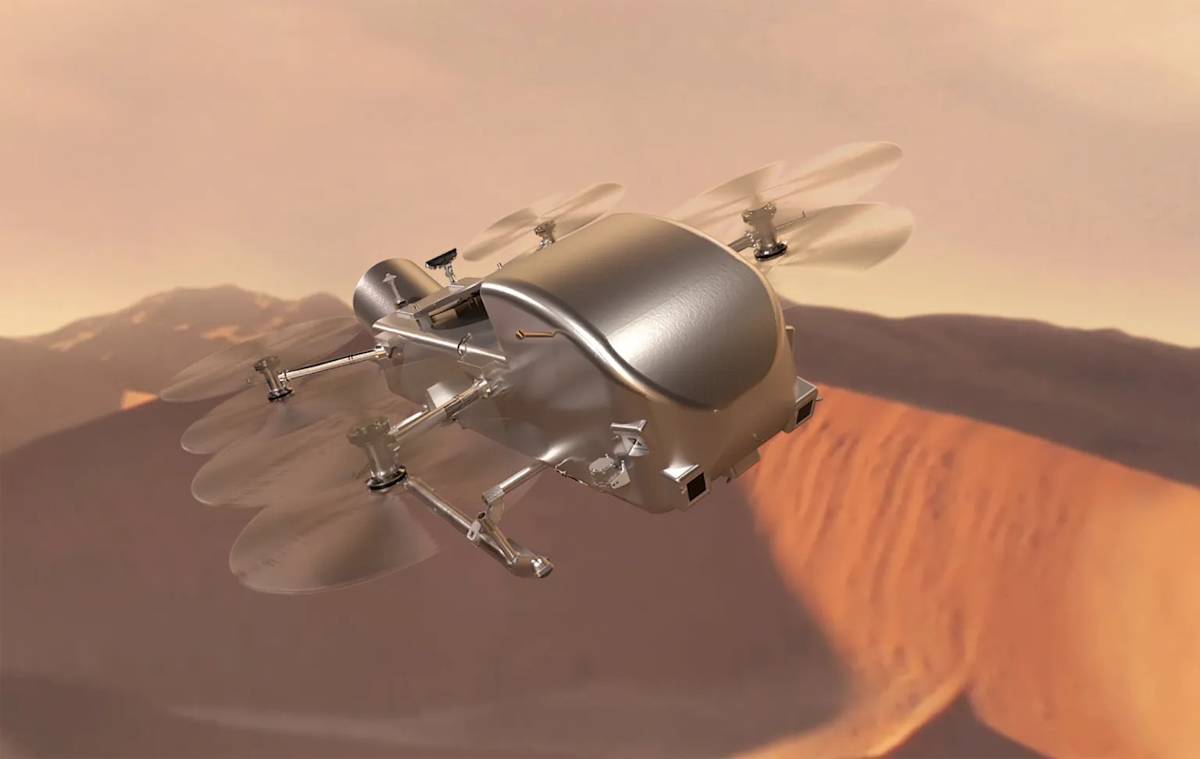(Image by Steve Gribben/NASA/Johns Hopkins APL)
If you’ve ever dreamed of exploring alien worlds, Titan might just become your next obsession. Saturn’s largest moon is a place of paradoxes: it’s freezing cold, yet brimming with organic chemistry; it’s drenched in methane rain, yet eerily Earth-like in its landscapes. And in 2028, NASA plans to send a flying robot there - not a rover, not a lander, but a drone. A nuclear-powered, eight-rotor, science-packed flying machine called Dragonfly.
Titan is no ordinary moon. It’s bigger than Mercury and wrapped in a thick, golden-orange atmosphere - even denser than Earth’s. In fact, it's the only moon in our solar system with an atmosphere to call its own. That atmosphere is mostly nitrogen, with a generous helping of methane, creating a smoggy veil that hides a surface sculpted by rivers, lakes, and dunes. But instead of water, Titan’s rivers flow with liquid hydrocarbons. It’s a world where the familiar meets the bizarre, and where the building blocks of life may be quietly brewing beneath the ice.
This is why Titan has captured the imagination of scientists and storytellers alike. It’s a frozen time capsule, possibly echoing the conditions of early Earth. Complex organic molecules swirl in its skies and settle on its surface, forming what some call a “prebiotic soup.” That’s science-speak for the kind of chemistry that might one day evolve into life - or might already have, hidden deep below.
In fact, billions of years from now the sun is expected to swell in size as it nears the end of its life. For the best part of a billion years it will put out enough heat to warm Titan. It might just become a new Earth, although its lifespan will be a lot shorter than the planet that we are privileged to call home.
But, back to the present, to explore this alien world, NASA is building Dragonfly, a car-sized rotorcraft designed to fly across Titan’s surface like a giant robotic insect. Scheduled to launch in July 2028 aboard a SpaceX Falcon Heavy, Dragonfly will arrive at Titan in 2034 after a six-year interplanetary cruise. Once there, it will do something no spacecraft has ever done: take off, fly, land, and repeat - all on an alien moon, well over a billion miles away.
Dragonfly is a marvel of engineering and it’s a symbol of how far we’ve come; from the Wright brothers to flying machines designed for controlled flight on another moon. It uses eight rotors arranged in four pairs, giving it the ability to hover, manoeuvre, and land vertically. Titan’s thick atmosphere and low gravity make flying easier than on Earth, so Dragonfly will be able to soar with surprising efficiency. Instead of solar panels, which wouldn’t work well under Titan’s dim skies, it’s powered by a Multi-Mission Radioisotope Thermoelectric Generator, a kind of nuclear battery that provides a steady stream of energy to keep its instruments running and its rotors spinning.
And, speaking of instruments, Dragonfly is a mobile science lab, equipped with cameras for panoramic views, a mass spectrometer to analyse surface samples, and tools to study Titan’s weather and subsurface composition. More than that, because Titan is so far away, Dragonfly will fly itself, using autonomous navigation to scout new landing sites and avoid hazards. It’s a robot with brains and wings.
The mission’s goals are as ambitious as its design. Dragonfly will explore Titan’s chemistry, assess its habitability, and search for signs of life. It will hop between dozens of sites, starting in the Shangri-La dune fields and eventually making its way to Selk Crater - a place where water and organics may have mixed in the past. That’s a recipe for life, and a tantalizing target for exploration.
If successful, Dragonfly could pave the way for future missions to other moons like Europa or Enceladus. It might even help us answer one of humanity’s oldest questions: are we alone?
So, let's hope for a successful lift off in 2028 and a safe arrival on Titan in 2034 and then we'll need to keep an eye on two sets of skies - not just Earth’s, but Titan’s - because somewhere out there, a robot named Dragonfly will fire up its rotors, take flight and do it all in the name of science.
